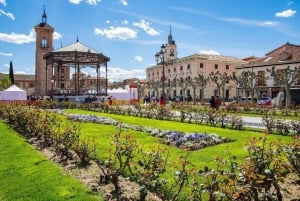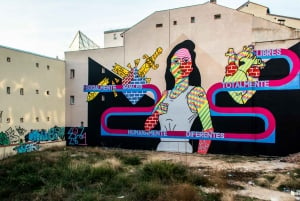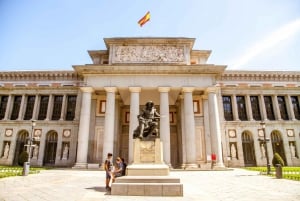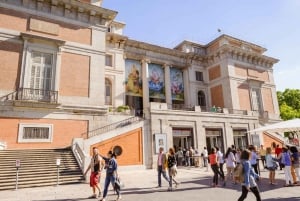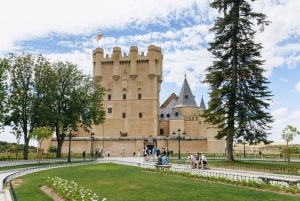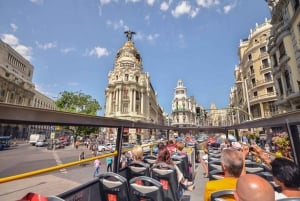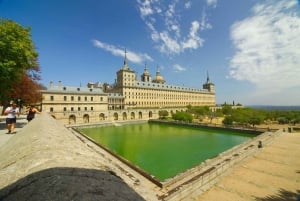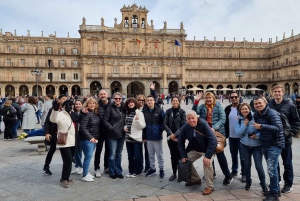Traditional shops
La Mallorquina
Founded in 1894. One of the traditional bakeries in Madrid, creators of the "Neapolitan" a bun filled with cream. If you are at the Puerta del Sol, you´ll surely smell the aroma coming out of this shop and you won´t be strong enough to... resist temptations.
Puerta del Sol, 8 / Mayor, 2
Casa Diego
Open since 1823, it manufactures hats, fans, umbrellas and shawls. They work for the Royal Houses worldwide. Princess Letizia carried one of their fans on their wedding day.
Puerta del Sol, 12
Casa Yustas
It´s not only a store, its considered a historical monument dated to the XVI century.
It has a large exhibition of head wear, typical products and handicrafts.
Plaza Mayor 30
La Favorita
It opened its doors in 1894, the date from which the sale is dedicated to top hats, bowler hats, felt hats and bonnets.
Plaza Mayor 25
Capas Seseña
Founded in 1901, it is devoted to handmade clothing layers. It still uses traditional methods of cutting and sewing by hand, as they have done for over a hundred years.
Seseña is recognized as representative of classic fashion of Spain and has been used by prominent figures such as the Spanish Royal Family or Hillary Clinton, through artists like Picasso, Buñuel, Rudolph Valentino and Placido Domingo as well as names of literature and cinema as Hemingway, Gary Cooper, Catherine Deneuve and Federico Fellini.
De la Cruz 33
Lardhy
Lardhy has been serving food to locals since 1839. It is without any doubt one of the most traditional restaurants in Madrid. The Romanticist beauty shop windows made of mahogany from Cuba, give it a refined and exclusiveness that invites people to come and taste any of the seasonal products offered at any time in the shop-floor bar, where you can grab a snack, drink a Martini, a Rioja wine or a glass of Port or Sherry. If you want something more, just go upstairs to the room through the front door open on the streets of San Jeronimo.
The store decoration has been kept intact since the day it opened to the public: two marble counters left and right, and below a console on which a fine wine shop rests and a "bouilloire" on which there is a great mirror that gives it a more romantic setting.
Upon entering the room upstairs, we find the Elizabethan room, as well as the white and the Japanese, that maintain the same level of comfort and taste as the last century.
Despite the traditional style and refined way of doing things, Lardhy restaurant has also been ground-breaking with old habits and customs. It was the first restaurant to allow access for single women, a written menu, fixed prices and individual tables, all without doubt which was a style that differed from the other inns and bakeries of the time.
Its most famous dishes are: the stews that have been serving for almost two hundred years to regular patrons, aristocrats, politicians and cultural figures.
The secret kept for almost two hundred years as one of the restaurants of reference for both locals and foreigners is definitely the way they take care of every detail on the table, in the preparation of the dishes, the quality of raw materials and the excellent wine cellar In addition to the fine pastries.
Lardhy restaurant is probably the most quoted in the Spanish literature, having been the focus of gatherings for writers and cultural figures.
In their rooms, President General Primo de Rivera used to hold meetings with his ministers. King Alfonso XII use to escape from the palace to enjoy their cooking. In 1916, the famous spy "Mata Hari" was arrested on leaving the restaurant. Writers such as Gómez de la Serna, Baroja or Azorín were honored in these halls. As a result of their meals and subsequent gatherings, brothers Alvarez Quintero, Jacinto Benavente and Carlos Arniches come together to promote the intellectual talks.
Carrera de San Jeronimo 8
Posada del Peine
On Postas Street, near to the Plaza Mayor, its located what it could be probably considered the oldest hotel in Madrid. It was founded in 1610, to provide bed-linen service to travelers who came to the city to sell their products. Its name comes from the courtesy that the establishment had with guests providing them with a comb that left tied up in the sink so it does not carry him.
Thanks to the economic development of their charges, 1 peseta (Spanish former currency) in 1909, it was a huge success. As a result of this they expanded the business, annexing the current building situated on Postas Street.
As for that time standards, it was a hotel with many rooms, some of them very spacious and bright exterior and some other interior ones, small and poorly ventilated, which led to associate the hotel to a poor quality standard.
Room 126, had a connecting passage way to other rooms and even it was a secret room, where fugitives and smugglers were hidden.
In 2005, it reopened again as a 4-star hotel, upon completion of a major reform both inside and outside
Postas 17
Bodegas Mariano Madrueño
It began serving wine in 1895 in downtown Madrid. It was a kind of warehouse where good wines of different denominations of origin were served and at very attractive prices.
A good selection of wines is seen in the shop window but only when you go in, will you see hundreds of bottles at good prices.
Postigo de San Martín 3
Casa Botín
The oldest restaurant in the world! According to the Guinness Book of World Records, there were proof of its existence already in 1590, shortly after King Philip II, moved the Court to Madrid.
Its wood oven, which dates from 1725, emanates a scent that attracts everyone who walks close to try their famous young pigs.
Botín appears in the Spanish literature regularly. Benito Pérez Galdós alludes to it in one of his famous novels: Fortunata and Jacinta or Mercy.
Botín is still a meeting place for the world of culture. In its restaurant Graham Greene, Truman Capote and Hemingway have enjoyed meals.
Famous are the tributes that Hemingway has given to reflect how much he enjoyed meals here: "I ate a very big meal and drank three bottles of rioja alta. "
Cuchilleros 17
Cuesta Moyano
It´s not a shop per se, but since it is a permanent group of book stands we're including in this section.
Of the ancient fairs held in Madrid, only a few still survive, and one of them is the permanent Book Fair held next to Atocha Square.
In 1919 the book stalls were located on Paseo del Prado, opposite the Botanical Garden, but at the request of its director who realized what an unhealthy place it was, they were moved to current location, on Moyano hill.
In 1925, the replacement of pine drawers where the books were displayed by the permanent establishment of stands were authorized to a maximum of 30.
A more proper location has long been discussed, but it has finally been located on the site it is today since 1925.
Cuesta Moyano
Pastelería el Riojano
It was founded in 1855 by Don Damaso de la Maza, who was the pastry chef at the Royal Palace. Damaso wanted independence so the Queen offered her best craftsmen to furnish the new bakery. The cover and the windows are a marvel of the best that can be found in Madrid.
Among their wide range of specialties we can refer to the French toasts, bartolillos (dumplings cream), the imperial cake, the tiramisu and the San Marcos one.
They have a nice lounge area inside.
Mayor 10
Casa Alberto
This is one of the oldest taverns in Spain, a Madrid tavern with all its characteristic features.
Miguel de Cervantes lived here in 1613 - 1614. It was in this apartment where he wrote several chapters of the second part of Don Quijote as well as "The Persiles and Segismunda" novel and where he finished his book: "Journey to Parnassus. "
Originally it was a tavern that offered simple wines accompanied by a slice of cold meat, a boiled egg or a piece of dried cod for ... In the 20's, they expanded their offerings and decided to serve a gastronomic menu for the tastes of the time in which the seafood stood out.
Nowadays at Casa Alberto a traditional spoon dish is always served : cooked lentils; beans with chorizo and pork ear, ribs with potatoes and soups ...
Huertas 18
Mercado de San Miguel
The San Miguel market occupies the site where in its day the church of the same name stood. The origins of the temple go back at least to 1202, and as it was customary at that time, merchants were placed around them to offer their products. The church suffered a disastrous fire in 1790, so it was demolished during the reign of King Jose Bonaparte, however the spot remained as a location for merchants and their products in an outdoor area.
Later on the influence of the new trends that began to prevail at the time, it was required to maintain better hygiene and urban sanitation. In 1835, it was covered up to hide the bad effects produced by the rows of stalls and boxes of traders in view of passers by, as Mesonero Romanos wrote in his manual of Madrid in the XIX century.
According to Pascual Madoz recounts, it seems that in 1847 there were: 128 boxes and 88 stalls.
In the end the project to raise a closed market was entrusted to the architect Alfonso Dubé, and it was finally opened in 1916.
The market in San Miguel, is the only example that has survived to date with iron structures.
The market consists of a ground floor with a metal frame of cast iron supports and a ceramic crown crest on the roof.
Currently it intends to be a place to merge the idea of a traditional market where you can purchase high quality and seasonable products, along with bars where you can enjoy the typical Spanish custom of enjoying an aperitif before lunch or dinner or have a snack at any time of day.
Plaza de San Miguel
Mercado de la Paz
One of the best ways to really get to know how locals live in any country, is by visiting their local food markets.
Since 1882, people of the best neighborhoods of the capital come daily to buy the freshest and selected products that fill their pantries.
It´s the only market in Madrid built in the nineteenth century that continues to carry out its traditional business: brings the finest products to clients who go there every day
It seems that the original plans of the building were designed by Gustavo Eiffel, who projected an iron structure to lift the building. They were then other architects who finally constructed the building.
Ayala 28
Casa Crespo
A sandal shop established in 1836 that used to export to provinces. In the 70´s they renewed their models and spread the range of colors; as an immediate consequence there were long queues to get their pair of hand made sandals, and Casa Crespo became a place to which locals are devoted.
Divino Pastor 29
El Rastro
More than a set of shops, it´s an open market, open on the street on Sunday mornings where thousands of locals go in search of a lost treasure at a bargain price.
Already in the fifteenth century, in the vicinity of what is now Cascorro Square, thrift shops, sellers of old and used clothes, abattoirs and tanneries were located, and all of them created a very active trade in the area.
In the seventeenth century they began to sell stolen products, along with food vendors, bakeries and hardware.
In the nineteenth century, the second-hand dealers, auctions and antique shops setup there.
Sunday morning, among a lot of junk, are things of merit, which attract more and more public in search of bargain and opportunities.
Plaza de Cascorro



